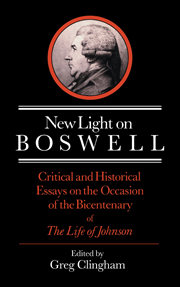 New Light on Boswell
New Light on Boswell 1 - Introduction: Boswell's ambiguities
Published online by Cambridge University Press: 28 October 2009
Summary
James Boswell remains one of the most fascinating and puzzling figures in literary history. Regarded at one time as a shallow egoist who succeeded by some kind of naive mimetic ability in producing one of the greatest of biographies, thus becoming an accidental genius, he is now visible to us as a much more complex and artful person whose inner tensions and contradictions are bound up with remarkable talents. The massive Boswell repository now at Yale, with its diaries, letters, notes, drafts, and other manuscripts, has yielded and continues to yield multiple new insights into Boswell's mind and art. No fully agreed synthesis has emerged. As the following pages show, it is possible to explain and evaluate Boswell and his work in many different ways and to interpret the relation between his life and character on the one hand and his literary output on the other very diversely. There is no dispute, however, about his interestingness or, in spite of the various ways in which his sensibility can be related to moods and fashions of his age, about his originality.
Before the publication of his journals, Boswell's fame rested almost entirely on his Life of Johnson, though his Journal of a Tour to the Hebrides with Samuel Johnson LL.D. and, to a lesser extent, his Journal of a Tour to Corsica were also admired. But his diaries and the other papers now at Yale have enlarged the whole context of our awareness of the man and his complexities and enabled us to read the familiar works with new eyes.
- Type
- Chapter
- Information
- New Light on BoswellCritical and Historical Essays on the Occasion of the Bicententary of the 'Life' of Johnson, pp. 1 - 8Publisher: Cambridge University PressPrint publication year: 1991


